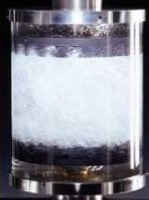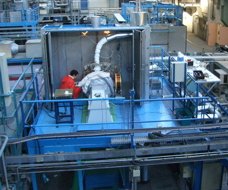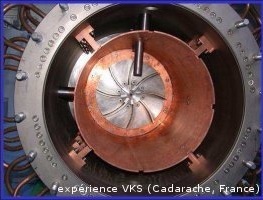von Karman flow: a paradigm for turbulence study



During my PhD that I did at CEA Saclay in France under the supervision of François Daviaud and Bérengère Dubrulle, I have started to study axisymmetric turbulent flows in the framework of out-of-equilibrium statistical mechanics. At the same time, as part of the VKS team, I have studied the possibility of dynamo effect in a turbulent flow of liquid sodium. Both studies where mostly experimental and the turbulent flow of interest was of the von Karman type.
Selected publications:
PRL 97 p074501 (2006)
PRL 98 p044502 (2007)
EPL 77 p59001 (2007)
PRL 101 p074502 (2008)
PRL 96 p124502 (2006)
PRL 101 p174502 (2008)
PHD thesis/thèse
Collaborators:
Statistical mechanics and turbulence
Describing turbulence with tools borrowed from statistical mechanics is a long standing dream starting with the pionneering work of Onsager in the fifties. In the nineties, the simultaneous breakthrough made by Miller and by Robert and Sommeria allowed a continous description of vorticity fields in the restricting case of Euler equations without forcing. In this framework steady states are obtained through the maximisation of a mixing entropy under the constraint of the conserved quantity along the flow dynamic. In the 2D case, vorticity is conserved and it possioble to describe draw the phase space with a single control parameter. These encouraging results give a strong motivation to upgrade the theoritical developments to the more realistic 3D situation. Nevertheless, in this case, vortex streching is present and prevents one to go through the required calculations. Axisymetric flows appear as a good intermediate situation since they share most of the 3D features (including vortex stretching) but at the same time they lead to calculations that are formally 2D.
Statistical mechanics of axisymmetric flows:
Leprovost, Dubrulle and Chavanis have extended the work of Robert and Sommeria to study axisymmetric turbulent flows. They showed that in the absence of forcing, the steady solutions of the Euler equations are selected through the maximisation of a mixing entropy under the constraint of the conserved quantities along the flow dynamic. Additionaly to angular momentum and vorticity, there is an infinite number of possible conserved quantities associated to an infinite number of possible solutions of the Euler equation. For actual flows, forcing and viscosity can not be neglected anymore since they are the source of the flow itself. Nevertheless, one may expect that in permanent regime, the injected and the dissipated energy balance each other so that the flow may be described with these tools. In order to check this assumption, I have performed experimental measurements in a von Karman geometry: the flow takes place in a closed cylinder and forcing is performed by the counter rotation of two impellers fitted with curved blades. In this geometry Reynolds number (Re) of the order of 500.000 are easily obtained when the working fluid is water, and when using water/glycerol mixing, one may explore four decades of Reynolds numbers, down to about 100.
Main results:
Using the experiment presented on the picture, I showed that the relations predicted for the stationnary solutions in the force-free inviscid case are also observed experimentally on the four decades of Reynolds number explored. The evolution of these relations when increasing the Reynolds number from 100 to 100.000 shows that at the limit of the very high Re, the von Karman flow behaves as a Beltrami flow for wich velocity and vorticty are aligned everywhere. As Beltrami flows are analytical solutions of the Euler equations, we were able to derive in this particular case relations for the fluctuations of angular momentum and of vorticity. We show that these fluctuations can be linked to the steady solutions through simple relations mimicking the classical "fluctuation-dissipation" relations. We checked experimentally that these relations are also verified in the von Karman case at high Reynolds number.
Dynamo effect
In 1919, sir Joseph Larmor, has proposed that a dynamo effect could be responsible of generation of the Sun magnetic field. At that time, dynamo effect was already used to generate electricity, but by involving solid conductors and even the possibility of a fluid dynamo was unsure. Since then, theoretical, numerical and experimental results have supported this statement and the dynamo origin of natural magnetic field is now the most shared hypothesis. In 2000, two experiments in Riga and in Karlsruhe allowed the first observations of an experimental fluid dynamo. Nevertheless, in these experiments, the fluid was constrained to follow a prescribed flow that was theoretically known as dynamogen. A challenging issue was then to build an unconstrained dynamo in which the fluid would fill the whole experimental volume.
The VKS experiment:
Several experimental set-up were designed around the world to fullfil these requirements. They all involve a flow of liquid sodium wich has good properties for dynamo effect (low density, high electrical conductivity). One is based in Perm (Russia) and takes place in a torus geometry, two others are settled in Maryland and Madison (USA) with spherical geometries. The last one was built in Cadarache by a French collaboration involving three teams from Ecole Normale Supérieure de Paris, Ecole Normale Supérieure de Lyon and CEA Saclay. The flow is of the von Karman type, takes place in a cylindrical geometry and is then known as VKS experiment for von Karman sodium experiment.
A laboratory dynamo:
On September 2006, the VKS experiment has for the first time allowed to see a dynamo effect in an unconstrained laboratory experiment. When both disc are in exact counter rotation, the generated magnetic field is stationary and its geometry is mostly a dipole aligned with the experiment axis of symmetry. When both disc have different velocities (i.e. when a global rotation component is present), the magnetic field presents richer dynamics including periodic orbits, chaotic reversals quadrupolar mode and intermittent behaviour.
Since then:
A tricky aspect of the VKS experiment lays in the fact that the dynamo observed have been observed so far only when the impellers are made of ferromagnetic iron. This questions a lot about the role of pure iron on the onset of dynamo action. The whole VKS team has .
© Romain Monchaux
Template design by Andreas Viklund